|
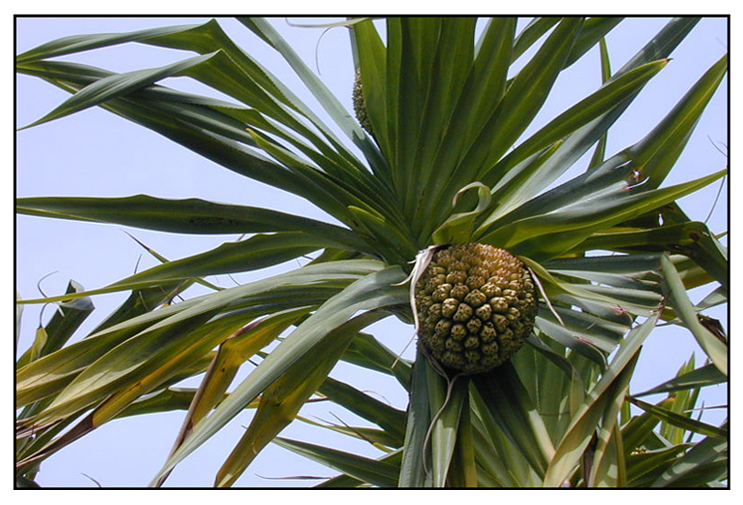 Gen info Gen info
- Pandanus is a genus of monocots of about 600 known species, varying in size from small shrubs less than a meter to medium-sized trees of about 20 meters.
- In the Philippines there are 48 species of Pandanus, many of them are endemic, growing in various habitats, from sandy beaches, mangroves and primary forests. The fruit of some species are edible, eaten by bats, rats, crabs, elephants and lizards. The majority of species are dispersed primarily by water.
- Pandanus tectorius was first described by Sydney Parkinson in 1744. It is an angiosperm belonging to the genus Pandanus of the family Pandanaceae.
- Etymology: The genus name Pandanus is Latinized from the Malayan name "pandang", which refers to the screw pine. The species epithet tectorius derives from Latin, referring to rooftops or growing on rooftops or tiles, a uncertain reference. (35)
Botany
• Pandan is an erect, branched
small tree, growing 3 to 5 meters high; the trunk bearing many prop roots.
Leaves are spirally crowded toward the ends of the branches, glaucous,
linear lanceolate, slenderly long-acuminate, up to 1.5 meters
long, 3 to 5 centimeters wide, the margins and midrib beneath towards the apex, armed with sharp spiny
teeth that point toward the apex of the leaf. Male inflorescence
is fragrant, pendulous, up to 0.5 meter long. Fruit is solitary,
pendulous, ellipsoid to globose-ellipsoid, about 20 centimeters long,
each composed of 50 to 75 or more, obovoid, angular, fibrous and fleshy drupes,
4 to 6 centimeters long, narrow below and truncate at the apex; the stone 4- to 10-celled, slightly sulcate between the cells of the apex, becoming yellow-red to bright red-orange at maturity.
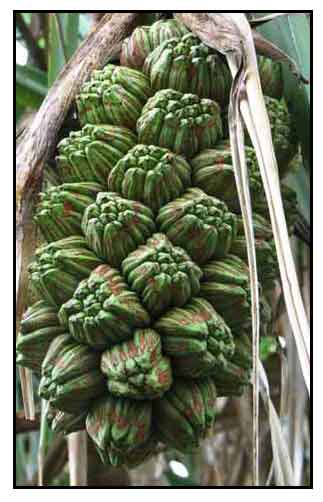 • P. tectorius is a small tree that grows upright to reach 4–14 m (13–46 ft) in height. The single trunk is slender with brown ringed bark. It is spiny, grows to 4.5–11 m (15–35 ft) in width, and forks at a height of 4–8 meters (13–26 ft). It is supported by aerial roots (prop roots) that firmly anchors the tree to the ground. Roots sometimes grow along the branch,and they grow at wide angles in proportion to the trunk. Flowers: Pandanus tectorius is dioecious, meaning male and female flowers are borne on separate trees, with very different male and female flowers. Male flowers, known as racemes, are small, fragrant, and short-lived, lasting only a single day. Flowers are grouped in 3 and gathered in large clusters surrounded by big, white bracts. Clusters are about 1 ft in length and are fragrant. Female flowers resemble pineapples. Fruit: The female P. tectorius trees produce a segmented, large fruit. Although not closely related, the fruit resembles a pineapple. Fruit is either ovoid, ellipsoid, subglobose or globose with a diameter of 4–20 cm (1.6–7.9 in) and a length of 8–30 cm (3.1–11.8 in). Fruit is made up of 38–200 wedge-like phalanges, often referred to as keys or carpels, which have an outer fibrous husk and are 8 inches in length, roughly 40 to 80 keys in each fruit and the color of the fruit can be yellow, orange, or red with a green top. Phalanges contain two seeds on average, with a maximum of eight reported. Phalanges are buoyant, and the seeds within can remain viable for many months while being transported by ocean currents. Leaves: Leaves are usually 90–150 cm (3.0–4.9 ft) in length and 5–7 cm (2.0–2.8 in) in width, with saw-like margins, spirally arranged at the end of the branches. Some varieties have spines along the edges and ribs throughout the leaves. (8) • P. tectorius is a small tree that grows upright to reach 4–14 m (13–46 ft) in height. The single trunk is slender with brown ringed bark. It is spiny, grows to 4.5–11 m (15–35 ft) in width, and forks at a height of 4–8 meters (13–26 ft). It is supported by aerial roots (prop roots) that firmly anchors the tree to the ground. Roots sometimes grow along the branch,and they grow at wide angles in proportion to the trunk. Flowers: Pandanus tectorius is dioecious, meaning male and female flowers are borne on separate trees, with very different male and female flowers. Male flowers, known as racemes, are small, fragrant, and short-lived, lasting only a single day. Flowers are grouped in 3 and gathered in large clusters surrounded by big, white bracts. Clusters are about 1 ft in length and are fragrant. Female flowers resemble pineapples. Fruit: The female P. tectorius trees produce a segmented, large fruit. Although not closely related, the fruit resembles a pineapple. Fruit is either ovoid, ellipsoid, subglobose or globose with a diameter of 4–20 cm (1.6–7.9 in) and a length of 8–30 cm (3.1–11.8 in). Fruit is made up of 38–200 wedge-like phalanges, often referred to as keys or carpels, which have an outer fibrous husk and are 8 inches in length, roughly 40 to 80 keys in each fruit and the color of the fruit can be yellow, orange, or red with a green top. Phalanges contain two seeds on average, with a maximum of eight reported. Phalanges are buoyant, and the seeds within can remain viable for many months while being transported by ocean currents. Leaves: Leaves are usually 90–150 cm (3.0–4.9 ft) in length and 5–7 cm (2.0–2.8 in) in width, with saw-like margins, spirally arranged at the end of the branches. Some varieties have spines along the edges and ribs throughout the leaves. (8)
Distribution
- Native to the Philippines.
-
In thickets along
seashores throughout the Philippines.
- Also native to Bismarck Archipelago, Caroline Is., Cocos (Keeling) Is., Cook Is., Fiji, Gilbert Is., Hawaii, Jawa, Lesser Sunda Is., Line Is., Maluku, Marianas, Marquesas, Marshall Is., Nauru, New Caledonia, New Guinea, New South Wales, Niue, Pitcairn Is., Queensland, Samoa, Santa Cruz Is., Society Is., Solomon Is., Tokelau-Manihiki, Tonga, Tuamotu, Tubuai Is., Tuvalu, Vanuatu, Wake I., Wallis-Futuna Is.
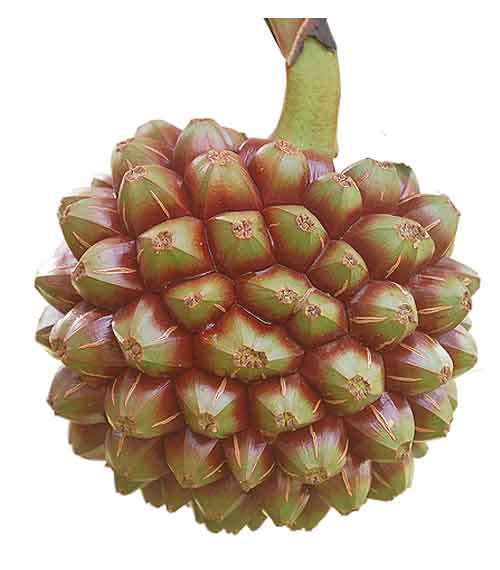 Constituents Constituents
- Essential oil, alkaloids,
glycosides, isoprene esters, and tannin.
- Blossoms yield an essential oil.
- Keora oil contains diterpene, d-linalool, phenylethyl acetate, citral,
phenylethyl alcohol ester, ester of phthalic acid, fatty acids and steroptene.
- Pandanus fruits contain significant amounts of vitamin C.
- Also contains significant amounts of provitamin A carotenoids.
- Phytochemical study of various extracts of leaves yielded glycoside, carbohydrates, phytosterols, saponins, phenolic compounds, proteins and amino acids, terpenoids, flavanoids, fixed oil and fats.
- Qualitative analysis of fruit extracts yielded phenolics, flavonoids, terpenoid, steroids, saponins, and glycosides. (see study below) (18)
- Study of fruit yielded a new dihydrofurocoumarin, named pandanusin A (1), along with 15 known compounds i.e., one furanocoumarin (2)
, two coumarins (3,4), four lignans (5-8), one neolignan (9), two flavonoids (10,11), three phenolics (12-14), one monoglyceride (15), and one monosaccharide (16). (see study below) (19)
- Fruits yielded two new phenolic compounds, Pandanusphenol A and B.
(20)
- Study of fruit by chromatography methods isolated one new aldehyde compound, (Z)-4-hydroxy-3-(4-hydroxy-3-methylbut-2-en-1-yl) benzaldehyde (1), along with six known aldehydes, p-hydroxybenzaldehyde (2), syringaldehyde (3), (E)-ferulaldehyde (4), (E)-sinapin-aldehyde (5), vanillin (6) and 5-hydroxymethylfurfual (7). (see study below) (33)
Properties
- The prop roots possess diuretic properties.
- Oil and attar considered stimulant and antispasmodic.
- Considered emmenagogue.
- Fruits of wild forms contain calcium oxalate crystals which may cause mouth irritation.
- Studies have suggested anti-inflammatory, uterine stimulant, antioxidant, anticoagulant, antibacterial, antitubercular, diuretic, cytotoxicity, neurobehavioral, antidiabetic, anti-hyperlipidemic, antinociceptive, anticancer, antihypercholesterolemic, antiatherosclerosis, α-glucosidase inhibitory, memory enhancing properties.
Parts utilized
Leaves, flowers, roots.
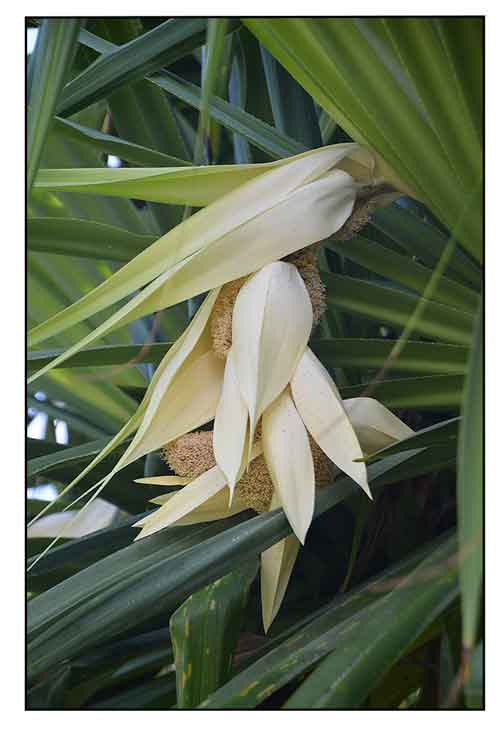 Uses Uses
Edibility / Culinary
- An aromatic leaf used to perfume
rice dishes.
- Ripe fruits of wild forms can be consumed after cooking and straining of the pericarp of the fruits.
Folkloric
- Decoction of fresh or dried prop root drunk for diuretic effect.
- Roots used to strengthen the gums.
- In the Philippines, as far back as 1837, water from cuts made near the base of the trunk use to stimulate urination.
Headache, arthritis, stomach spasms: Decoction of leaves.
- Poultice of
fresh leaves mixed with oil also used for headaches.
- Wound healing: Pulverized dried leaves used to facilitate wound healing.
- Poultice of mash of cabbage of plant, mixed with salt and juice of Citrus
microcarpa, for abscesses.
- Decoction of roots believed to have aphrodisiac and cardiotonic properties.
- Also used for arthritis and to prevent spontaneous abortion.
- Chewing the roots strengthens the gums.
- Decoction of aerial roots use as beverage for cases of blennorrhea.
- Decoction of roots combined with sap of banana plant for urethral injections
for variety of urinary complaints.
- Leaves of plant triturated into a mash, slightly salted and added with juice of Citrus microcarpa,
used as hot poultice for new boils.
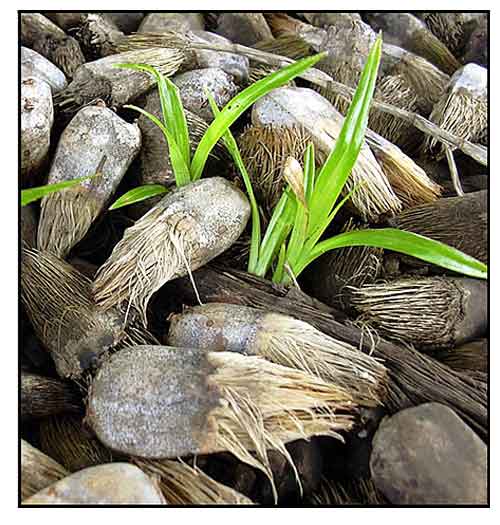 - In Ayurveda, leaves used for filarial diseases, leucorrhea, leprosy, smallpox, scabies, syphilis and
leukoderma. - In Ayurveda, leaves used for filarial diseases, leucorrhea, leprosy, smallpox, scabies, syphilis and
leukoderma.
- In traditional Indian systems, used for filarial disease, leucorrhea and as emmenagogue.
- Anthers of male flowers used for earaches and headaches.
- In the Marshall Islands, used for abnormal menstrual bleeding, after delivery, infant jaundice, colic and restlessness. (5)
- In Palau, roots used to make a drink to alleviate stomach cramps. Leaves used to alleviate vomiting.
- In Vanuatu, a spoonful of grated stem bark mixed with a small cup of grated coconut flesh used to induce sterility. (26)
Others
- Perfume: Male flowers used for making perfume. (17)
- Decorative: Use of flowers or seeds in making leis.
- Craft: Leaves and roots used as wreathing material for making mats, baskets, ropes and nets. (17)
Studies
• Anti-Inflammatory: Fresh juice of the aerial root of Pandanus tectorius produced i34.5 % inhibition of carrageenin-induced edema.
• Intestinal Motility / Uterine Stimulant: Study in rats suggest stimulant property on gastrointestinal motility and uterine stimulant action.
• Antibacterial: Study results indicate that Pandanus tectorium have antibacterial effects on B subtilis but not on E coli, P aeruginosa, C albicans or S aureus. (3)
• Antitubercular / Triterpenes and Phytosterols: Study of a chloroform extract of leaves yielded a new tirucallane-type triterpene, 24,24-dimethyl-5β-tirucall-9(11),25-dien-3-one (1), squalene and a mixture of the phytosterols stigmasterol and β-sitosterol. Compound 1 inhibited the growth of Mycobacterium tuberculosis H37Rv with a MIC of 64 μg/mL, while squalene and the sterol mixture have MICs of 100 and 128 μg/mL, respectively. (7)
• Phenolic Compounds and Flavonoids / Fruits: Study isolated 15 compounds (ten phenolics and five flavonoids) from the fruits of P. tectorius. Of the compounds, trans-ethyl acetate was the highest one with about 0.1% of the dry material. Most of the compounds possessed anti-oxidative activities, with some anti-inflammatory activities. (10)
• Diuretic / Leaves: A previous study has shown diuretic activity in a leaf extract. This study isolated squalene (1) from a chloroform extract. Both squalene 1 and the chloroform extract exhibited positive diuretic effects, although no comparable to the positive control, furosemide. (13)
• Neurobehavioral Activity / Leaves: Study evaluated an ethyl acetate fraction and n-butanol fraction of hydroalcoholic leaf extract for neurobehavioral activity using elevated plus maze, open field test and forced swim test in mice models. Results showed antidepressant and anxiolytic action. Phytochemical screening yielded flavonoids which could be responsible for the pharmacological action. Acute toxicity study on mice per OECD guidelines showed no significant toxicity. (14)
• Anti-Hyperlipidemic / Caffeoylquinic Acids: Study evaluated the anti-hyperlipidemic effect and mechanism of action of P. tectorius fruit extract in hamsters fed a high fat-diet. Treatment with PTF-b (fruit ethanol extract) enriched in caffeoylquinic acids (CQAs) significantly stimulated the activation of AMP-activated protein kinase (AMPK) as well as serum and hepatic lipoprotein lipase, with moderation of hyperlipidemia and improvement of liver lipid profile. (16) Study yielded ten caffeoylquinic acids (CQAs) from the anti-hyperlipidemic extract of fruits of P. tectorius. Three CQAs tested in HepG2 cells significantly reduced the intracellular content of total cholesterol and total triglycerides. (22)
• Antioxidant / Antibacterial / Cytotoxicity Study / Fruits:Study evaluated the antibacterial and antioxidant activities, total phenolic content and cytotoxicity properties of P. tectorius fruit extracts against normal and cancer cell lines (HeLa, HepG2 and MCF-7). An ethyl acetate extract from fruit core parts showed highest antioxidant capacity (IC50=0.8 ± 0.20 mg/mL), while an ethyl acetate extract from key parts showed highest antibacterial activity with inhibition zone of 10-15 mm, but less than commercial antibiotics. On cytotoxicity study, all extracts did not show activity against all selected cell lines (IC50>30 µg/mL. (see constituents above) (18)
• α-Glucosidase Inhibitory Activity / Fruits:Study of fruits yielded one new dihydrofurocoumarin, named pandanusin A, along with 15 known compounds (2-16). The isolated compounds (1-12, 14) showed better α-glucosidase inhibitory activity (IC50 range of 14.4-81.5 µM) than standard drug acarbose (IC50=215.5 µM). (see constituents above) (19)
• Antitubercular
Triterpenes and Phytosterols / Leaves: Bioassay-guided chromatographic purification of the antitubercular chloroform extract of P. tectorius var. laevis leaves yielded a new tirucallane-type triterpene, 24,24-dimethyl-5β-tirucall-9(11),25-dien- 3-one (1), squalene and a mixture of the phytosterols stigmasterol and β-sitosterol. The new triterpene inhibited the growth of Mycobacterium tuberculosis H37Rv with MIC of 64 µg/mL, while squaline and the sterol mixture have MICs of 100 and 128 µg/mL, respectively. (21)
• Cytotoxic Steroids / KB (Human Epidermal Carcinoma) Cell Line / Stem Bark:Study of n-hexane extract of stem barks showed good cytotoxicity activity against KB (a human epidermal carcinoma) cell line with IC50 of 45.33 µg/mL. Study of the extracts isolated four compounds viz. stigmast-4-en-3-one (1), stimasta-4,22-dien-3-one (2), cycloucalenol (3), and stigmast-22-en-3ß-ol (4). Compound 2 showed moderate cytotoxic activity against KB cell line with IC50 of 88.96 µg/mL. (23)
• Anti-Inflammatory / Antinociceptive
/ Leaves: Study evaluated the anti-inflammatory and antinociceptive activity of ethanolic extract of fresh leaves of P. tectorius using carrageenan-induced paw edema in rats and tail-flick method in mice. Results showed anti-inflammatory activity equivalent to phenylbutazone; activity was attributed to inhibition of prostaglandins and leukotrines release. Antinociceptive activity was comparable to ibuprofen. Phytochemical screening yielded tannins, steroids, triterpenes, and flavonoids. (24)
• Increase Insulin Sensitivity / Regulation of Hepatic Glucose and Lipid Metabolism / Caffeoylquinic Acid / Fruit: Study evaluated the antihyperglycemic and antihyperlipidemic effects of CQA-rich P. tectorius fruit extract in diabetic mice. Treatment with the fruit extract significantly decreased body weight and fasting glucose levels, alleviated hyperinsulinism and hyperlipidemia, and decreased glucose levels in OGTT. Results suggest CQA-rich fruit extract may alleviate hyperglycemia and dyslipidemia via activation of AMPK-AS160-GLUT 4 pathway in skeletal muscle and inhibition of gluconeogenesis and lipogenesis in the liver. (25)
• Anticoagulant / Antoxidant / Leaves: Study evaluated the acute toxicity, antioxidant activities, and anticoagulant activities of P. tectorius leaves. Acute toxicity study showed LD50 of 176.78 mg/mL. DPPH assay at extract concentrations of 500, 250, 125 and 62.5 mg/mL showed percentage inhibition of 95.01, 81.39, 59.26, and 25.81 respectively, compared to vitamin C at 300 mg with 98.14% inhibition. Crude ethanol extract of leaves induced significantly (p<0.05) increased clotting time. Warfarin used as positive control showed more than 50% anticoagulant activity than the ethanol plant leaves extract of P. tectorius. The mechanism of anticoagulant activity was not clear. Results suggest potential for the leaves extract as antioxidant and anticoagulant. (27)
• Nanoparticles / Antihypercholesterolemic / Chitosan-P. tectorius Fruits: Study reports on the synthesis of nanoparticles of chitosan-P. tectorius fruit extract and its cytotoxicity against HepG2 by MTT assay. The NPs showed not cytotoxic activity against HepG2 cells. In vivo study showed NP treatment can reduce levels of total cholesterol (197%), LDL (360%) and TG (109%), and increase HDL cholesterol by 150%. The NPs were nontoxic to the liver. Results suggest effective in reducing hypercholesterolemia via SR-B1 pathway. (28)
• Antioxidant / Anticancer / Fruits: Study evaluated the antioxidant and cytotoxicity properties of ethyl acetate fractions of P. tectorius fruit extract on HeLa cell lines. All seven fractions of EA extract showed high DPPH free radical scavenging activity with IC50 range from 0.3 to 2.4 mg/mL compared to positive control quercetin (0.2 mg/ml). One fraction showed cytotoxicity against HeLa cell lines with IC50 of 12 µg/ml (less than 30 µg/ml). Results indicated P. tectorius fruit has very good potential as antioxidant an anticancer agent. (29)
• Modulation of Gut Microbiota / Antihyperlipidemic / Fruits: Study evaluated the role of Pandanus tectorius fruit (PTF) extract on the modulation of gut microbiota and antihyperlipidemic effects. PTF was effective in ameliorating high-fat diet (HFD)-induced hyperlipidemia and significantly changed the structure of gut microbiota. The anti-hyperlipidemic effect was not influenced by co-treatment with antiobiotics (ampicillin + norfloxacin). PTF selectvely enhanced the relative abundance of Lactobacillus and decreased the abundance of Bacteroides and Alistipes. Correlation analysis showed Lactobacillus was negatively associated with serum lipids and gluse while Bacteroides and Alistipes were positively associated with serum lipids and glucose. Results suggest the polyphenol-rich PFT is a unique gut microbiota modulating agent. (30)
• Effect as Food Additive on Disease Resistance of Fish Cyprinus carpio: Study evaluated the effect of Pandanus tectorius extract on fish Cyprinus carpio growth, antioxidant capacity, immunological and oxidative stress, immune related gene expression, and resistance against pathogen challenge. PT improved the antioxidant status, improved the immune status and disease resistance, and altered the expression of antioxidant- and inflammation-related genes. Fish fed 20 g/kg showed highest disease resistance capacity. (31)
• Antihypercholesterolemic / Antiatherosclerotic / Fruits: Study evaluated the potency of P. tectorius fruit as antiatherosclerosis and antihypercholesterolemic agents through regulation of HDL-receptor (scavenger receptor [SR]-B1) gene expression and 3-hyderoxy-3-methylglutaryl coenzyme A reductase (HMGCR) in vitro, respectively. P. tectorius fruit was noncytotoxic against HepG2 cell line. The fruit upregulated SR-B1 gene expression and downregulated the HMGCR. It upregulated HDL and down-regulated total cholesterol, and showed on effect on toxicity biomarkers SGOT and SGPT in vivo. Results suggest P. tectorius fruits have potential as preventive agent against hypercholesterolemia and atherosclerosis via SR-B1 and HMGCR mechanisms. (32)
• α-Glucosidase Inhibitory / Fruit: Study of fruit by chromatography methods isolated one new aldehyde compound, (Z)-4-hydroxy-3-(4-hydroxy-3-methylbut-2-en-1-yl) benzaldehyde (1), along with six known aldehydes, p-hydroxybenzaldehyde (2), syringaldehyde (3), (E)-ferulaldehyde (4), (E)-sinapin-aldehyde (5), vanillin (6) to and 5-hydroxymethylfurfual (7).
Compounds 1-6 showed better α-glucosidase inhibitory activity (IC50s from 36.5 to 192.4 µM) than standard drug acarbose (IC50 214.5 µM).
(33)
• Effect on Spatial Memory Ability / Leaves: Study evaluated the effect of P. tectorius leaves extract (EEPTL) on increasing spatial memory using 25 male mice (Mus musculus) in 5 groups. Groups were induced using ethanol for three weeks and tested for spatial memory using the Y-maze method. Results showed EEPTL significantly increased mice's spatial memory ability (p<0.05). The most effective dose was 300 mg/kbw. GC-MS analysis revealed active compounds such as palmitic acid, stearic acid, coumarin, and 3-benzoyl-4-phenyl-ethyl linoleic. (34)
• Protective to Liver and Kidney in Diabetic Rats / Antioxidant / Roots, Stems, Leaves: Study evaluated the potential of different parts of P. tectorius to attenuate diabetes and its related complications. Water extract of stem and ethanol extract of roots produced maximum fall in sugar level of alloxan induced diabetic rats. Extracts showed positive effect on liver enzymes and lipid profile. Water extract of roots showed highest antioxidant potential by DPPH free radical scavenging assay. Phytochemical screening yielded presence of flavonoids, alkaloids, tannins, and saponins.
(36)
• Antidiabetic / Leaves: Study
evaluated the antidiabetic activity of ethanolic extract of pandan tikar (P. tectorius) leaves in white Wistar male rats induced with alloxan. Results showed antihyperglycemic effect. The optimal dose of pandan tikar leaves ethanolic extract was 375 mg/kbw, with 56.72% decrease, not significantly different from glibenclamide. (37)
• Anti-Atherosclerosis / Cytotoxicity / Fruit: Study evaluated the potency of fruit rich in tangeretin and ethyl trans-caffeate from P. tectorius for atherosclerosis prevention through inhibition of HMG-CoA reductase activity. Sample was extracted using hexane, ethyl acetate and methanol. Results showed all extracts inhibited the activity of HMG-CoA reductase with highest activity obtained by PMK (9x higher than pravastatin). All samples showed no cytotoxicity against HepG2 cells line with IC50 > 30 µg/mL. Study showed P. tectorius fruit rich in tangeretin and ethyl trans-caffeate has potential as candidate for treatment of atherosclerosis. (38)
• Fabrication of Natural Fiber / Leaves: The natural cellulose fiber extract from P. tectorius leaves is comprehensively investigated as a viable alternative for synthetic based fibers made from petro-chemical that is non-degradable and toxic. Pandanus tectorius leaves fiber is extracted and evaluated as reinforcement in polymer composite for engineering applications.
The extraction process resulted in 73% cellulose percentage for 10wt.% NaOHa and 120 min treatment. A combined alkali-bleach cellulose fiber composite showed 40% higher tensile strength compared to untreated cellulose fiber composite at 35 2.8MPa. (39)
• Lignan / Cytotoxicity Against HeLa Cell Line / Leaves: Study of leaves isolated a new lignan, named (8S, 8′S)-2,2',3,3'-tetramethoxy-4'-hydroxy-epoxylignan-4-O-β-D-glucoside (1), together with eight known compounds (2–9). Compound 1 was tested for cytotoxicity in vitro against three selected tumor cell lines (A549, HeLa, and MCF-7) by MTT assay. Compound 1 showed moderate cytotoxicity against HeLa cells with IC50 of 19.30 µM. (40)
Availability
Wildcrafted.
Small scale commercial production. |



 • P. tectorius is a small tree that grows upright to reach 4–14 m (13–46 ft) in height. The single trunk is slender with brown ringed bark. It is spiny, grows to 4.5–11 m (15–35 ft) in width, and forks at a height of 4–8 meters (13–26 ft). It is supported by aerial roots (prop roots) that firmly anchors the tree to the ground. Roots sometimes grow along the branch,and they grow at wide angles in proportion to the trunk. Flowers: Pandanus tectorius is dioecious, meaning male and female flowers are borne on separate trees, with very different male and female flowers. Male flowers, known as racemes, are small, fragrant, and short-lived, lasting only a single day. Flowers are grouped in 3 and gathered in large clusters surrounded by big, white bracts. Clusters are about 1 ft in length and are fragrant. Female flowers resemble pineapples. Fruit: The female P. tectorius trees produce a segmented, large fruit. Although not closely related, the fruit resembles a pineapple. Fruit is either ovoid, ellipsoid, subglobose or globose with a diameter of 4–20 cm (1.6–7.9 in) and a length of 8–30 cm (3.1–11.8 in). Fruit is made up of 38–200 wedge-like phalanges, often referred to as keys or carpels, which have an outer fibrous husk and are 8 inches in length, roughly 40 to 80 keys in each fruit and the color of the fruit can be yellow, orange, or red with a green top. Phalanges contain two seeds on average, with a maximum of eight reported. Phalanges are buoyant, and the seeds within can remain viable for many months while being transported by ocean currents.
• P. tectorius is a small tree that grows upright to reach 4–14 m (13–46 ft) in height. The single trunk is slender with brown ringed bark. It is spiny, grows to 4.5–11 m (15–35 ft) in width, and forks at a height of 4–8 meters (13–26 ft). It is supported by aerial roots (prop roots) that firmly anchors the tree to the ground. Roots sometimes grow along the branch,and they grow at wide angles in proportion to the trunk. Flowers: Pandanus tectorius is dioecious, meaning male and female flowers are borne on separate trees, with very different male and female flowers. Male flowers, known as racemes, are small, fragrant, and short-lived, lasting only a single day. Flowers are grouped in 3 and gathered in large clusters surrounded by big, white bracts. Clusters are about 1 ft in length and are fragrant. Female flowers resemble pineapples. Fruit: The female P. tectorius trees produce a segmented, large fruit. Although not closely related, the fruit resembles a pineapple. Fruit is either ovoid, ellipsoid, subglobose or globose with a diameter of 4–20 cm (1.6–7.9 in) and a length of 8–30 cm (3.1–11.8 in). Fruit is made up of 38–200 wedge-like phalanges, often referred to as keys or carpels, which have an outer fibrous husk and are 8 inches in length, roughly 40 to 80 keys in each fruit and the color of the fruit can be yellow, orange, or red with a green top. Phalanges contain two seeds on average, with a maximum of eight reported. Phalanges are buoyant, and the seeds within can remain viable for many months while being transported by ocean currents. 




